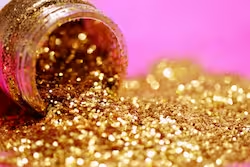Edible gold
Gold topped food is the new craze in exotic dining. Edible gold is 100% real gold sold as flakes, sprinkles or sheets. Premium hotels use it to give a royal and elite touch.

Gold topped pizza, Champagne with gold sprinkles, Gold plated sushi,.. sound exotic and rich? Edible gold is making a comeback.
It takes an expert chef with experience and skill to handle delicate gold toppings.
Edible gold is available as gold sheets or gold flakes. It is soft and delicate. It can wrinkle or tear easily if not handled with care.
It can be added to any type of cuisine, from candies and cup cakes to chicken wings and biriyani.
History of eating gold
Looking back in time, ancient Egyptians drank medicines mixed with liquid gold. They believed it to be the elixir of life. In the Middle ages, European royals decorated food with edible gold to give it a royal touch. In East Asia, gold was used in native medicine as a purifier. Gold has proved to be more than jewellery throughout history.
Can humans eat gold ?
When it comes to jewellery, pure 24 carat gold is soft. It should be mixed with impurities like copper or silver before it can be made in to jewellery. 18 carat gold is the standard for jewellery.
When it comes to edible gold, impurities are harmful to humans. So edible gold is 100% pure gold (24 carats).
Pure gold is melted at 2000 degree Fahrenheit (10 times hotter than an oven) and poured into bars. These bars are stretched by passing through rollers and hand pounded to form thin sheets.
Edible gold sheets can be as thin as 0.0001 millimetres.
Why people eat gold
A gold crested dinner platter is luxurious. It is a royal experience. No doubt, this experience comes with a hefty price tag. Normal biriyani costs 2.50 USD. Royal biriyani topped with gold crested lamb chops may cost around 250 USD. Same goes for coffee.. A cup of cappuccino costs around 5 USD. But a cup of cappuccino topped with 23k gold leaf costs over 35 USD.
Can you digest real gold ?
Gold is tasteless to the human tongue. A gold leaf is no more than a thin metal sheet. Pure gold is chemically inert, which means it does not react. Saliva cannot dissolve it. Acids and digestive juices in the human body cannot break down gold. If the gold we eat is small in size to pass through without causing an internal block, it passes through the digestive system and is sent out as waste.
Edible gold can do neither good nor bad to humans. It goes in and comes out. As simple as that.
